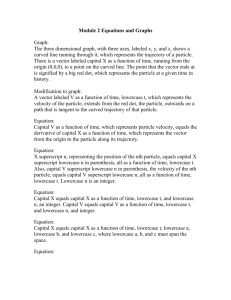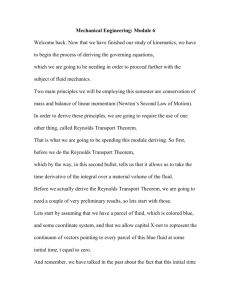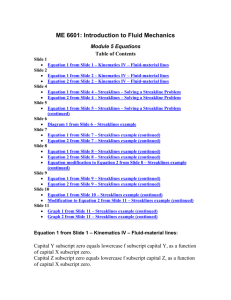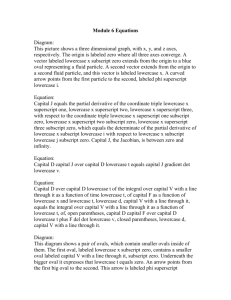Equations Transcript
advertisement
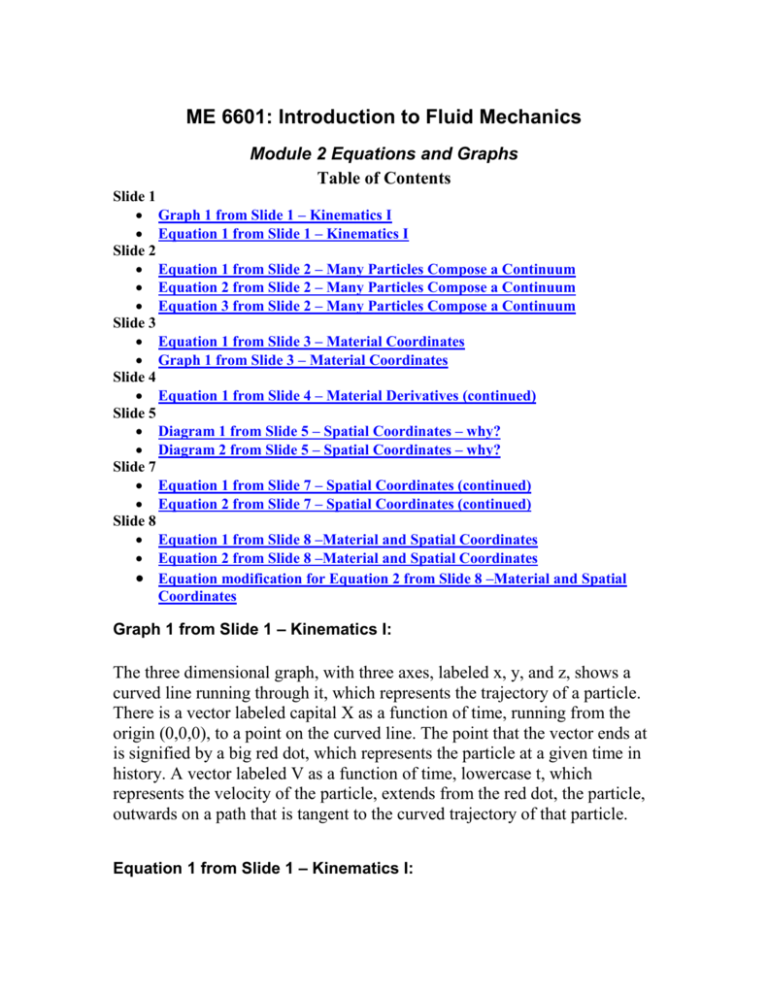
ME 6601: Introduction to Fluid Mechanics Module 2 Equations and Graphs Table of Contents Slide 1 Graph 1 from Slide 1 – Kinematics I Equation 1 from Slide 1 – Kinematics I Slide 2 Equation 1 from Slide 2 – Many Particles Compose a Continuum Equation 2 from Slide 2 – Many Particles Compose a Continuum Equation 3 from Slide 2 – Many Particles Compose a Continuum Slide 3 Equation 1 from Slide 3 – Material Coordinates Graph 1 from Slide 3 – Material Coordinates Slide 4 Equation 1 from Slide 4 – Material Derivatives (continued) Slide 5 Diagram 1 from Slide 5 – Spatial Coordinates – why? Diagram 2 from Slide 5 – Spatial Coordinates – why? Slide 7 Equation 1 from Slide 7 – Spatial Coordinates (continued) Equation 2 from Slide 7 – Spatial Coordinates (continued) Slide 8 Equation 1 from Slide 8 –Material and Spatial Coordinates Equation 2 from Slide 8 –Material and Spatial Coordinates Equation modification for Equation 2 from Slide 8 –Material and Spatial Coordinates Graph 1 from Slide 1 – Kinematics I: The three dimensional graph, with three axes, labeled x, y, and z, shows a curved line running through it, which represents the trajectory of a particle. There is a vector labeled capital X as a function of time, running from the origin (0,0,0), to a point on the curved line. The point that the vector ends at is signified by a big red dot, which represents the particle at a given time in history. A vector labeled V as a function of time, lowercase t, which represents the velocity of the particle, extends from the red dot, the particle, outwards on a path that is tangent to the curved trajectory of that particle. Equation 1 from Slide 1 – Kinematics I: Capital V as a function of time, which represents particle velocity, equals the derivative of capital X as a function of time, which represents the vector from the origin to the particle along its trajectory. Equation 1 from Slide 2 – Many Particles Compose a Continuum: X superscript n, representing the position of the nth particle, equals capital X superscript lowercase n in parenthesis, all as a function of time, lowercase t. Also, capital V superscript lowercase n in parenthesis, the velocity of the nth particle, equals capital V superscript lowercase n, all as a function of time, lowercase t. Lowercase n is an integer. Equation 2 from Slide 2 – Many Particles Compose a Continuum: Capital X equals capital X as a function of time, lowercase t, and lowercase n, an integer. Capital V equals capital V as a function of time, lowercase t, and lowercase n, and integer. Equation 3 from Slide 2 – Many Particles Compose a Continuum: Capital X equals capital X as a function of time, lowercase t, lowercase a, lowercase b, and lowercase c, where lowercase a, b, and c must span the space. Equation 1 from Slide 3 – Material Coordinates: The material coordinates lowercase a, lowercase b, lowercase c equal capital X subscript zero, which equals capital X as a function of 0 and capital X subscript 0. Graph 1 from Slide 3 – Material Coordinates: This three dimensional graph has three axes, the x, y, and z. It has a curved line running through it, depicting the trajectory of a particle. There is a vector traveling from the origin to the particle’s current position on it’s trajectory. This vector is labeled capital bold-faced X as a function of time, lowercase t. There is another vector traveling from the origin of the graph to the beginning of the trajectory, at time, lowercase t, equal to zero. This vector is labeled capital bold-faced capital X subscript zero. Equation 1 from Slide 4 – Material Derivatives (continued): Capital X equals capital X as a function of lowercase t and capital X subscript zero. Diagram 1 from Slide 5 – Spatial Coordinates – why?: This picture depicts a narrow tube of some kind, with a measuring device stuck into it that resembles a right-angle ruler. An arrow is used to show that fluid is passing through the tube in the direction of the arrow, past the measurement device. Diagram 2 from Slide 5 – Spatial Coordinates – why?: This diagram shows a device that bends the fluid as the fluid moves past, while at the same time measuring the fluid particles. A dotted box surrounds the fluid that is in the scope of the device’s measurements. Equation 1 from Slide 7 – Spatial Coordinates (continued): (All derivatives are done with respect to time, lowercase t, unless otherwise noted) The partial derivative of capital theta subscript lowercase x equals the partial derivative of lowercase theta subscript lowercase x times the partial derivative of time subscript lowercase x subscript zero plus the partial derivative of lowercase theta with respect to lowercase x subscript lowercase i, with the whole derivative having a subscript lowercase t, times the partial derivative of x with a subscript i, with a subscript for the whole partial derivative of x subscript zero. Equation 2 from Slide 7 – Spatial Coordinates (continued): The partial derivative of time with respect to time subscript one. The partial derivative of lowercase x subscript lowercase i with respect to lowercase t with a subscript of lowercase x subscript zero equals partial derivative of uppercase X subscript lowercase i with respect to lowercase t with a subscript of lowercase x subscript zero, equals capital V subscript lowercase i as a function of capital X subscript zero and time. Equation 1 from Slide 8 –Material and Spatial Coordinates: (All derivatives are with respect to time, unless otherwise stated): The partial derivative of capital theta, with a subscript lowercase x subscript zero equals the partial derivative of lowercase theta subscript lowercase x, plus lowercase v subscript lowercase i as a function of bold lowercase x and time, lowercase t, times the partial derivative of lowercase theta with respect to lowercase x subscript lowercase i, with the whole derivative having a subscript of lowercase t. Equation 2 from Slide 8 –Material and Spatial Coordinates: (All derivatives are with respect to time, unless otherwise stated): The partial derivative of capital theta equals the partial derivative of lowercase theta plus lowercase v subscript lowercase i times the partial derivative of lowercase theta with respect to lowercase x subscript lowercase i. The partial derivative of capital theta equals the partial derivative of lowercase theta plus lowercase bold v dot the gradient operating on theta. Equation modification for Equation 2 from Slide 8 –Material and Spatial Coordinates: The partial derivative of capital theta in the previous equation is replaced with capital D lowercase theta with respect to lowercase t.


